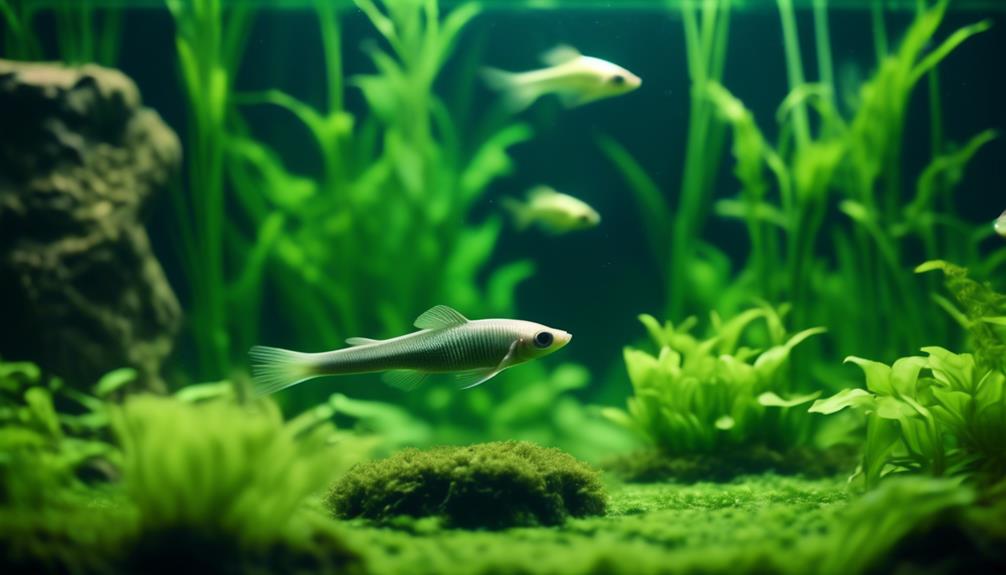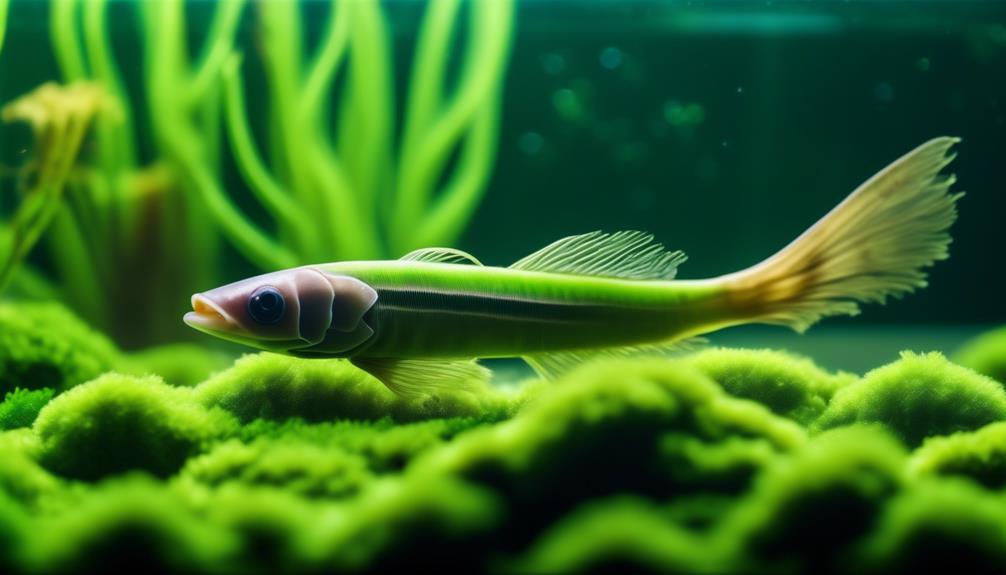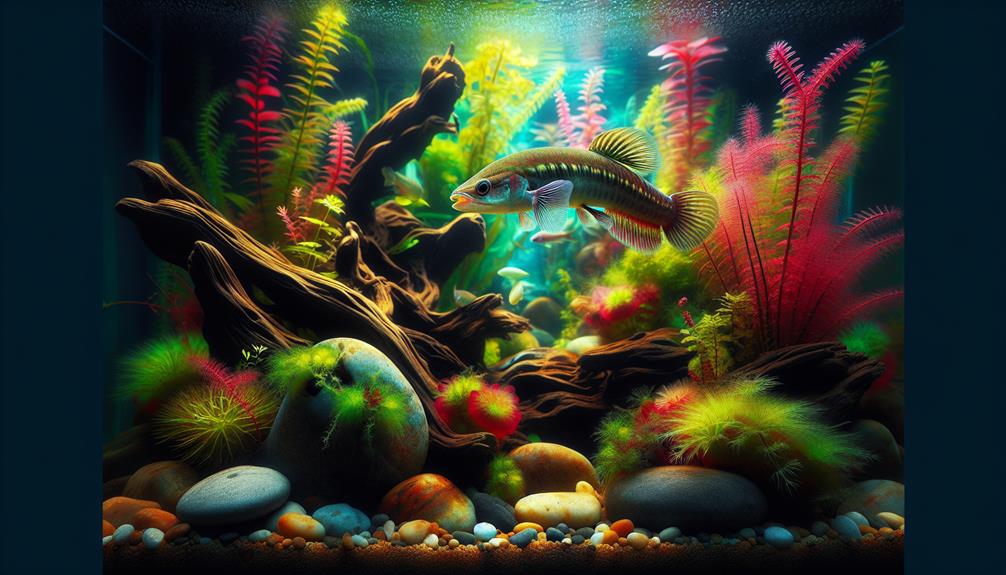Siamese Algae Eaters (SAEs) have long been revered in the world of freshwater aquariums for their remarkable ability to tackle algae growth. These torpedo-shaped fish, native to Southeast Asia, possess a striking appearance and a reputation for maintaining a healthy aquatic environment.
But what makes SAEs stand out from their counterparts, the Chinese Algae Eater and the Flying Fox? How can aquarists tap into their algae-eating power to unleash the full potential of these fascinating creatures?
In this discussion, we will explore the unique features of SAEs, the ideal setup for their thriving, compatible tank mates, their diverse diet, and valuable tips and tricks to maximize their algae-eating capabilities.
Prepare to dive into the world of Siamese Algae Eaters and discover the secrets behind their remarkable ability to transform and maintain a thriving aquatic ecosystem.
Key Takeaways
- Siamese Algae Eaters (SAEs) are freshwater fish known for their algae-eating abilities.
- SAEs have a torpedo-shaped profile, a sharp snout, and an eye-catching appearance.
- They can grow up to 6 inches long and have a black line down their side.
- SAEs are compatible with other community tank mates and can be kept in a 50-55 gallon freshwater aquarium.
The Algae-Eating Abilities of SAEs
Siamese Algae Eaters (SAEs) possess remarkable algae-eating capabilities, making them highly effective in maintaining a clean and algae-free aquarium environment. The benefits of having SAEs in a planted aquarium are numerous.
These fish are known to control different types of algae growth, such as green algae, black beard algae, and hair algae. SAEs have a voracious appetite for algae and can quickly consume large amounts of it, preventing its overgrowth and ensuring a balanced ecosystem.
Their ability to target different algae species makes them versatile in controlling various types of algae infestations. By keeping the aquarium free of excessive algae, SAEs contribute to the overall health and aesthetic appeal of the planted tank.
Their presence reduces the need for manual algae removal and chemical interventions, promoting a more natural and sustainable approach to aquarium maintenance.
Setting Up the Perfect Aquarium for SAEs
With the understanding of the algae-eating abilities of SAEs, it is crucial to create an optimal aquarium setup to ensure their well-being and maximize their algae control potential.
Choosing the right filtration system for SAEs is essential in maintaining water quality in their aquarium. A high-quality filtration system, such as a canister filter, is recommended to effectively remove waste and maintain water clarity. It is important to regularly clean and maintain the filter to prevent debris buildup and ensure proper functioning.
Additionally, regular water changes and monitoring of water parameters such as temperature, pH, and ammonia levels are necessary to maintain a healthy environment for SAEs. Installing a substrate that promotes the growth of beneficial bacteria can also help in maintaining water quality.
Finding the Right Tank Mates for SAEs

When selecting tank mates for Siamese Algae Eaters (SAEs), it is important to consider their compatibility with other fish species. SAEs are generally peaceful and can coexist with a variety of community tank mates. To ensure a harmonious aquarium environment, here are some key points to keep in mind:
- Compatibility with other algae eaters: SAEs can be housed with other algae eaters like Otocinclus catfish or Bristlenose plecos. These species have different feeding preferences and occupy different areas of the tank, reducing competition for food and minimizing aggression.
- Managing aggression in a group of SAEs: While SAEs are generally peaceful, aggression can occur within their own species, especially in smaller groups. To manage aggression, it is recommended to keep a group of at least three or more SAEs. This spreads out aggression and helps establish a more balanced social hierarchy.
- Choosing similar-sized, fast-swimming species: Pair SAEs with fish that have a similar size and active swimming behavior. This prevents SAEs from outcompeting slower-moving fish for food and ensures a more equitable distribution of resources.
Unleashing SAEs' Appetite: Their Diet and Feeding Habits
To ensure the optimal health and well-being of Siamese Algae Eaters (SAEs), it is crucial to understand their dietary requirements and feeding habits. SAEs are omnivorous and consume both protein and plant matter. Their diet can consist of flakes, wafers, freeze-dried foods, and blanched vegetables.
These fish have a small mouth that allows them to reach small food particles and algae. Juvenile SAEs primarily forage for nutrients and graze on various types of algae. However, as they grow older, they may prefer fish food over algae.
To encourage SAEs to eat algae and assist in algae control techniques, it is recommended to cut back their meal portions of fish food. This will stimulate their appetite for algae and help maintain a balanced ecosystem in the aquarium.
Tips and Tricks for Maximizing SAEs' Algae-Eating Power

In order to maximize the algae-eating power of Siamese Algae Eaters (SAEs), implementing effective strategies can significantly enhance their ability to control algae growth in an aquarium. Here are some tips and tricks for maximizing SAEs' algae-eating power:
- Provide a variety of natural algae control methods such as live plants, algae mats, and algae wafers. This will stimulate their foraging behavior and ensure a balanced diet.
- Create a well-maintained environment with proper water parameters, regular water changes, and good filtration. This will promote healthy algae growth and prevent excessive algae blooms.
- Introduce SAEs in groups rather than single individuals. This will encourage social behavior and increase their efficiency in controlling algae.
Frequently Asked Questions
How Long Do Siamese Algae Eaters Typically Live?
Siamese algae eaters typically live for 5 to 10 years. They require a diet that includes both protein and plant matter, such as flakes, wafers, freeze-dried foods, and blanched vegetables, to maintain optimal health and algae-eating capabilities.
Are Siamese Algae Eaters Suitable for a Beginner Fish Keeper?
Siamese algae eaters are suitable for beginner fish keepers due to their hardy nature and compatibility with community tank mates. They are efficient algae eaters and can coexist peacefully with other fish species.
Can Siamese Algae Eaters Be Kept in a Planted Aquarium?
Siamese algae eaters can be kept in a planted aquarium. Pros include their ability to control algae growth, while cons include potential nibbling on plant leaves. Tips for maintaining a healthy planted aquarium with Siamese algae eaters include providing ample hiding spaces and ensuring a balanced diet.
Do Siamese Algae Eaters Require Any Special Water Parameters?
Optimal water conditions for Siamese Algae Eaters include a freshwater aquarium with a capacity of 50-55 gallons. They are hardy and can tolerate a wide range of water parameters, making them compatible with various fish species.
Can Siamese Algae Eaters Be Kept in a Community Tank With Small Fish?
Siamese Algae Eaters (SAEs) can be kept in a community tank with small fish, provided they are compatible in size and swimming speed. SAEs are known for their algae-eating abilities and have an omnivorous diet.
Conclusion
In conclusion, Siamese Algae Eaters prove to be highly effective in maintaining a healthy aquatic environment through their remarkable algae-eating abilities. By setting up an aquarium with suitable conditions and compatible tank mates, aquarists can witness the transformative impact these fascinating fish have on maintaining a thriving aquatic ecosystem.
With their sharp snout and distinctive appearance, SAEs are a popular choice among aquarium enthusiasts. Their omnivorous diet and ability to consume both protein and plant matter make them a valuable asset in controlling algae growth.
Unleash the algae-eating power of Siamese Algae Eaters and witness the beauty of a well-maintained freshwater aquarium.

